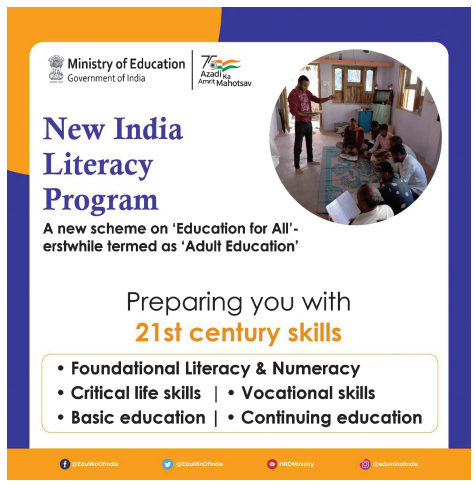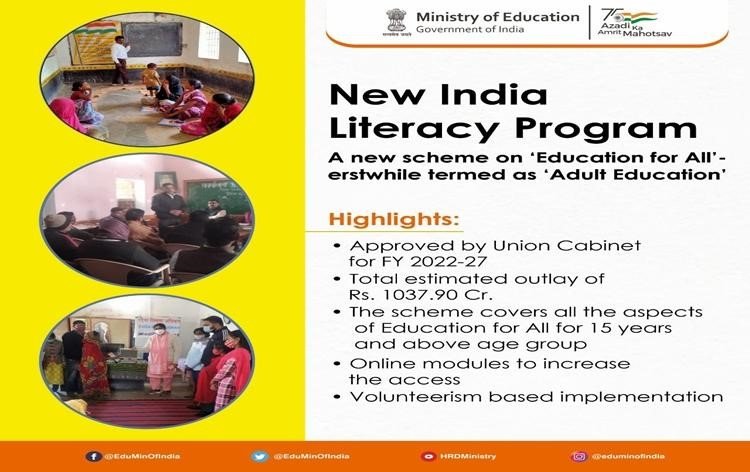31 Mar 2023 New India Literacy Programme
New India Literacy Programme
This article covers “Daily current events “and the topic is ‘The Finance Bill 2023’ which is in the news, it covers “Polity” In GS-2; the following content has relevance for UPSC.
For Prelims: New India Literacy Programme
For Mains: GS-2, Polity
Why in news: The New India Literacy Programme aims to make one crore adults literate this year, but relies on volunteer teachers and college students due to insufficient funds to hire teachers exclusively for adults.

New India Literacy Programme
About New India Literacy Programme
Aims to transform the Indian education system by promoting a more holistic and multidisciplinary approach to learning. The literacy program is a part of this larger initiative, aimed at improving literacy rates and quality of education in India.
Key objectives of the New India Literacy Programme
- To provide functional literacy and numeracy to all children in the age group of 3-9 years by 2025.
- To ensure that all children can read with comprehension and perform basic arithmetic operations by the end of grade 3.
- To provide opportunities for adult education and lifelong learning to all those who missed out on education earlier.
To achieve these objectives, the program will focus on providing age-appropriate learning materials, promoting multilingualism, strengthening teacher training and capacity building, and leveraging technology to enhance the reach and quality of education.

Objectives of the New India Literacy Programme
New Education Policy 2020: Need of the hour
There are several reasons why there is a need for the New India Literacy Programme.
- Despite several efforts in the past, India still has a significant population that is illiterate or has low levels of literacy. According to the 2011 Census, the literacy rate in India was 74.04%. This means that a large percentage of the population, especially in rural areas and among marginalized communities, do not have access to quality education or have dropped out of school early.
- Even those who are literate often lack basic skills in reading, writing, and numeracy. This is a major barrier to their social and economic mobility, as they are unable to access better job opportunities or participate effectively in civic and political life.
- There is a need for a more holistic and multidisciplinary approach to education, which focuses not just on academic learning but also on the development of critical thinking, creativity, and problem-solving skills. The New India Literacy Programme aims to address these gaps and provide a more comprehensive and inclusive education system that meets the needs of all learners.
In summary, the New India Literacy Programme is needed to address the gaps in the Indian education system and ensure that every child has access to quality education and the opportunity to develop to their full potential.
UGC guidelines for implementation of the New India Literacy Programme
The University Grants Commission (UGC) has issued guidelines for the implementation of the New India Literacy Programme (NILP) in colleges and universities. The guidelines are as follows:
- Setting up of a Literacy Cell: The institutions are required to establish a Literacy Cell to coordinate the activities related to NILP.
- Identifying the target group: The institutions need to identify the target group for the literacy program, which could include children in the age group of 3-9 years, adults who missed out on education earlier, and other marginalized communities.
- Curriculum Development: The institutions need to develop a curriculum that is age-appropriate, context-specific, and promotes multilingualism. The curriculum should focus on functional literacy and numeracy, as well as life skills.
- Training of teachers: The institutions are required to provide training to the teachers who will be involved in the literacy program. The training should include pedagogical techniques, language teaching strategies, and the use of technology in education.
- Community Participation: The institutions need to involve the community in the literacy program to ensure its sustainability and effectiveness. This could include engaging parents, local NGOs, and other stakeholders.
- Monitoring and Evaluation: The institutions are required to monitor and evaluate the progress of the literacy program regularly. The evaluation should include both qualitative and quantitative measures, such as assessment of learning outcomes, student and teacher feedback, and community participation.
In summary, the UGC guidelines for the implementation of the Programme provide a framework for colleges and universities to develop and implement effective literacy programs that meet the needs of their local communities.
Conclusion
New India Literacy Programme is a significant step towards achieving universal literacy and ensuring that every child in India has access to quality education. The program has the potential to transform the education system in India and provide learners with the skills and knowledge they need to succeed in the 21st century.
Source:
Read Daily Current Affairs for Yojna IAS


No Comments